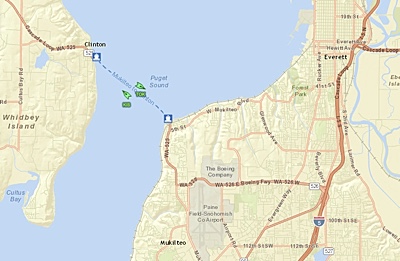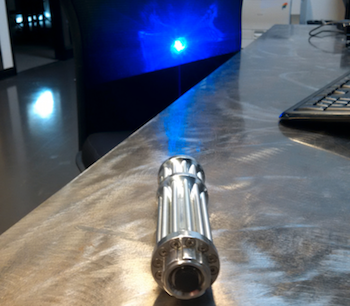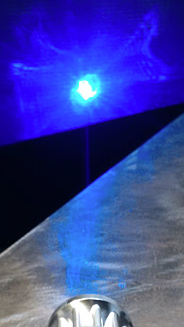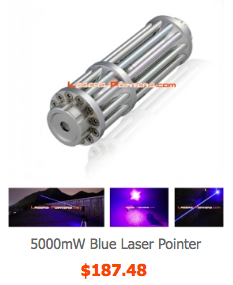Home
A comprehensive resource for safe and responsible laser use
US: Blue laser pointer said to injure ferry captain in Washington state
This map shows the ferries’ route. The map’s indicated positions of the ferries are from a later time and do NOT show their position during the laser incident.

At about 8:30 pm, the ferry M/V Tokitae (shown below) was approaching the Clinton (Wash.) Ferry Terminal. The captains were at wheelhouses on opposite ends of the 362-foot-long ferry. The one piloting the vessel was hit first, and suffered injuries.

According to Washington State Ferries Port Captain Jay Mooney, the man had “third-degree burns on his eyelid and his vision is still not quite back at 100 percent.” (A first-degree burn occurs only on the surface of the skin. A third-degree burn “extends to all layers of the skin,” according to the Wikipedia “Burn” article.)
The blue laser beam came from the slightly smaller ferry M/V Kitsap, which was traveling in the opposite direction.

A Kitsap deckhand had seen two men with the laser, and reported it to a Washington State Patrol trooper after arrival at the terminal in Mukilteo. One man told the officer that “it was a new toy and he was shining it at the water and didn’t mean to shine it at the vessel,” according to a WSP spokesperson. The trooper confiscated the laser pointer, shown here:

The spokesperson said “This is not a typical laser you’d see in a classroom or office setting.” She referenced the manufacturer’s packaging which says to use safety glasses, to not aim it at faces, and that it could light a match if held on target long enough.
A similar-looking laser sold by Lasers-Pointers.com is said to be 5000 mW (5 watts) and costs less than $200:
The two captains exposed to the laser light missed one day of work. The suspect who had the laser has not yet been charged, as of October 29 2015. Prosecutors are determining what charges would be appropriate.
UPDATED - November 9 2015: No arrests have yet been made and no charges have been filed, more than two weeks after a suspect was picked up. This is due in part to determining what jursidiction applied, since the laser incident took place on ferries in waters between different Washington state counties. Another difficulty was determining what charge to file. A KIRO radio story also noted the limitations of the U.S. Food and Drug Administration, which regulates lasers. While FDA attempts to block some high-powered lasers, imports can get through. And, “there aren't any penalties for buying or owning those illegally high-powered devices, nor are there requirements for training for non-medical, non-industrial devices.” From MyNorthwest.com
UPDATED - April 18 2015: 27-year-old Mark Raden was charged with assault in the third degree, for aiming at the ferry captains. In addition, he has a previous history of run-ins with law enforcement over laser misuse. Details are here.
An analysis of the laser’s power and capabilities is below (click on the “read more” link).
From KOMO News, Q13Fox, the Kitsap Sun and Wikipedia. Ferry drawings and route map from Washington State Department of Transportation website. Laser pointer info from Lasers-Pointers.com.
Analysis and commentary by LaserPointerSafety.com
A Washington State Patrol spokesperson said that the laser was manufactured for sale, and it was not “homemade” as at least one press report indicated. The website Lasers-Pointers.com sells a blue laser which looks identical to the one in the photo provided by the Washington State Patrol. According to the product webpage, the laser beam is 5000 milliwatts (5 watts) at 445 nanometers (blue).
However, the stated power is likely to be less than 5 watts. The most powerful single-diode blue handheld laser we are aware of, as of October 2015, has an actual power output of about 2 watts. For high-powered consumer handheld lasers, sellers frequently exaggerate the power. For example, the first commercial high-power blue handheld laser, the Wicked Lasers Arctic, was claimed to be 1 watt but routinely was in the 700-800 watt region. To give another example, we recently purchased a claimed 5000 milliwatt (5 watt) laser pointer from the Internet; it turned out to be about 50 milliwatts, or 100 times less powerful.
Whether the laser is actually 5 watts is one question. Another is about how tight the beam is. Laser beams spread out over distance. A laser that can burn materials at a few inches may be incapable of even causing heat on one’s hand a few yards away. Knowing the beam spread, or “divergence”, is therefore an important part of calculating the hazard distances of a laser.
Unfortunately, the Lasers-Pointers.com website gives no information for the divergence. The Washington State Patrol photo below, of the laser used in the incident, shows a large (wide) beam over a short distance. The beam appears to be at least a few millimeters across, along with extra light patterns due to poor beam quality. (In contrast, a photo of a good-quality beam would show just a dot or rectangle.) The WSP photo indicates a high divergence beam that spreads out relatively fast. Such a beam would create less of a hazard than a laser with the same power but in a tighter beam.

Eye and skin hazard distances
Could this laser have caused eyelid and retinal injuries to the ferry captain? Let’s start by assuming a worst case, that the laser really is 5 watts and that the beam has a relatively tight divergence of 2 milliradians. According to Skyzan laser safety software, this gives the following hazard distances for an accidental or undesired exposure:
- Nominal Ocular Hazard Distance: 819 feet. Beyond the NOHD, the laser beam is considered “safe” or that it has “a vanishingly small chance of causing injury”. Note however that being inside the NOHD does not mean automatic eye injury. At about 1/3 of the NOHD, or in this case 259 feet, there is roughly a 50-50 chance of causing a minimally detectable retinal lesion when the laser and eye are fixed (not moving) relative to each other under laboratory conditions. Details on how injury potential decreases with distance is here.
- Skin Hazard Distance: 23 feet. Beyond 23 feet, the laser should not be able to cause a burn or other change to a person’s skin.
Clearly, even if this inexpensive laser is truly 5 watts and has a tight beam, it could not have caused a third-degree burn to skin, under the circumstances of the two ferries passing at a laser-to-target distance of greater than 23 feet. For one thing, each ship is moving, both along a travel path and with the motion of the waves. Further, the laser was likely handheld. It is hard to hand-hold a beam steady on a target at distances of dozens or hundreds of feet. Such unsteadiness spreads out the beam over time, lowering the power density on any given spot and making it harder to cause a burn.
One buyer commenting on the Lasers-Pointers.com page, Cameron Malcolm, said that “the burning range is like about 15 to 20 feet.” For dark surfaces this corresponds to the Skyzan calculations. (The darker the surface, the more it absorbs heat and the easier it is for a laser to cause a burn.)
Also, while it a 5-watt 2 mrad laser beam could cause retinal injury in laboratory conditions up to 819 feet, under the ferry conditions — moving laser and target, handheld laser, uncooperative subject who blinks or turns away immediately — the chance of such a laser causing eye injury is lessened. Within a distance of 259 feet, under lab conditions, an injury would be likely. It would be helpful to know more about the claimed retinal injury’s location and severity.
(Update: The product information states that there is a focusing lens on the laser. According to laser safety expert Greg Makhov, this focusing is only effective at distances relatively close to the laser. Due to optical and physical effects, at distances beyond, say, 40 to 50 feet, the beam characteristics and thus hazard potential for this laser would be essentially the same.)
Visual interference hazard distances
Actual damage to eye or skin is not the only hazard of lasers. As shown by thousands of incidents reported to the U.S. FAA each year, laser light can also be bright enough to disrupt visual tasks such as flying a plane — or in this case, piloting a ship.
Again using the worst-case analysis of 5000 milliwatts and 2 mrad divergence, these are the visual interference distances:
- Afterimages and temporary flashblindness: 4,138 feet (0.78 miles)
- Interfering glare while the laser is on the eye: 18,500 feet (3.5 miles)
- Distraction, brighter than city or background lights: 185,000 feet (35 miles)
The laser was definitely a visual interference hazard. For the Tokitae captain at the docking end of the ship, having a vision-blocking afterimage is obviously hazardous while coming into port.
Conclusion
The above analysis is based on the worst case situation of 5 watts and 2 mrad divergence. Even based on these specifications, it is almost impossible to imagine that a handheld laser aimed from one ferry to another could cause any skin damage, much less a third-degree burn. This claim needs to be carefully examined by police, prosecutors and media.
While eye damage is possible, this claim also should be examined. The distance at time of exposure is one key missing piece of knowledge, as of course are the specifications of the actual laser used in the incident. The police should contact an experienced laser scientist, one familiar with the different ways of calculating beam power and divergence. Such calculations can be complex; they require the correct equipment and procedures for the type and power of laser.
All that being said, this still is a serious incident that deserves appropriate charges and punishment. By aiming a laser at other people, the perpetrator created a vision hazard and possible health hazard. He went against the seller’s clear warning as published on the Lasers-Pointers.com web page:
- “Our lasers [sic] pointers are for professionals, are not toys. These devices are not suitable to give to children or irresponsible persons. Do not aim the laser at people, animals or vehicles running. The glow of the beam can cause vision damage. The laser light bounces off glass and reflective surfaces. Extreme caution is recommended during use. For all power lasers over 5mW are needed goggles suitable for wavelength. Laser modification or misuse can result in a risk of injury and permanent eye damage. Lasers are generally used for astronomy, education, research, construction and other areas where they act as precise indicators. The buyer will be responsible for all damages caused by improper use or improper. Only an operator experienced with the proper training you have received training to an appropriate level should be allowed to exercise control over these systems.”
